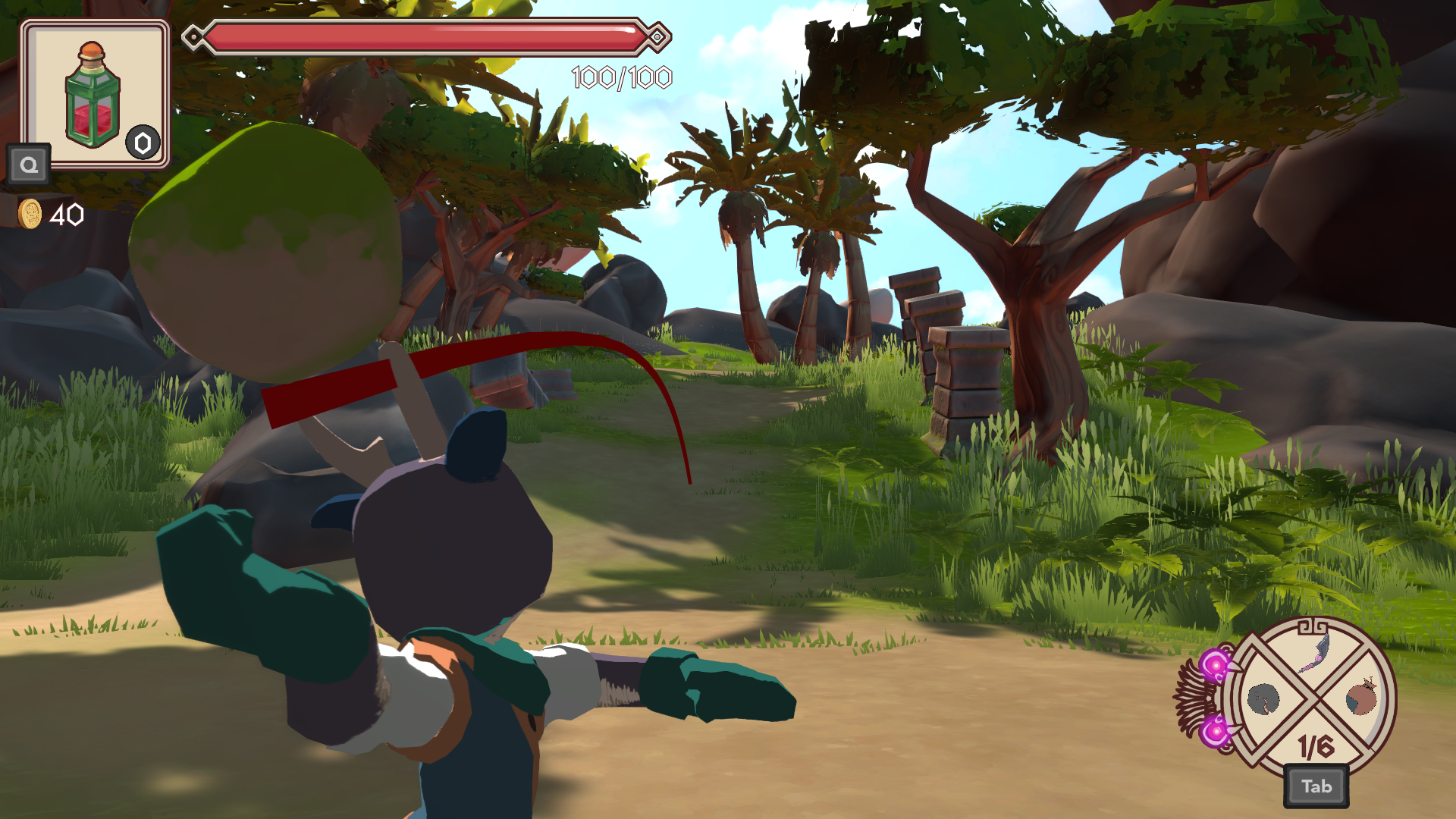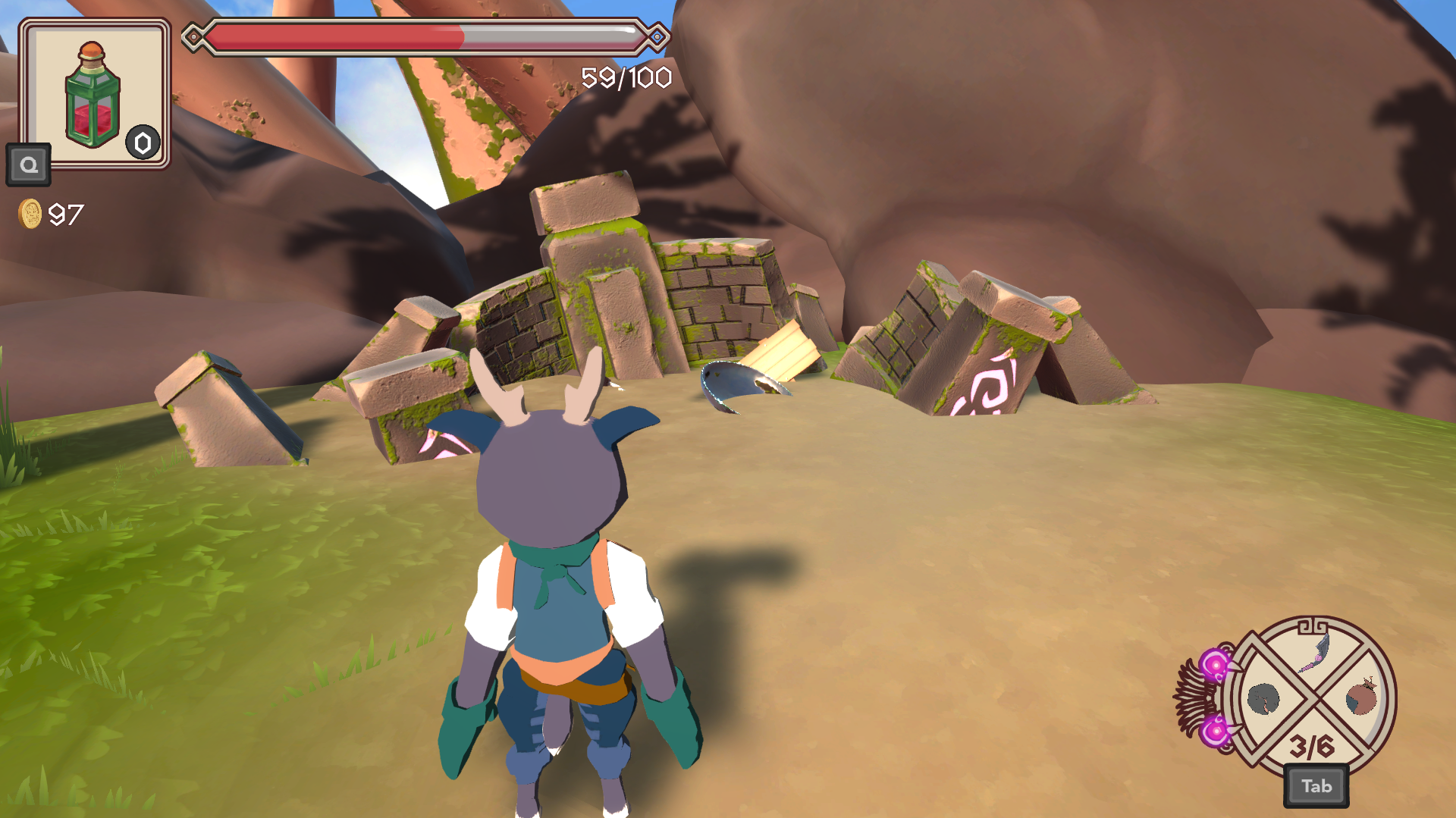












The Monument - 3rd Person Action Adventure
What is The Monument?
The Monument is a 3D explorative adventure game in which the primary mechanic is throwing. You throw objects to attack things, get loot, and sell it back to Teletel, a shopkeeper who talks to you about the state of the world.
The Monument was made in Unity 2019.3 in my junior year at DigiPen Institute of Technology with a team size of 13-15 people. Our team’s initial lineup was made up of 5 designers, 2 programmers, 1 sound designer, and 4 artists. Over the course of about 7-8 months, we worked on creating our initial vision of an adventure game with combat centered around throwing things.
What Did I Work On For The Monument?
As is the way with team projects everyone had to wear multiple hats and I end up wearing quite a few. On this project I served as the Level Designer, UX Designer, UI Designer, Lead Designer, and Co-Producer. My main responsibilites for this project were to lead the design team and the level design of the project. I was also in charge of the cutscenes in our game, our narrative team worked on the dialogue while I worked on the storyboard, cinematography, and setting them up in the engine.
Level Designer
My main focus for this project was to focus on level design and work together with Kyle (our other level designer), to produce an interesting semi-linear explorative map we could use for the setting. There were many obstacles in our way through our process of producing this level, but in the end we were able to complete the level, just not the one we initially wanted. My responsibilites were to design the overall concept of the level as well as design the forest area which took up about half of the map. Since neither me nor Kyle had ever worked with another Level Designer before we worked out a plan to split the work in half and then give each other feedback as we reached various points in our production. We worked together with the systems designer to design the placement of the encounters throughout the map.
UX Designer
From the beginning of the project I wanted to focus much more on Level Design then anything else, however as we had no other UX Designers at the time I did a lot of work on it. I worked together with the artists to get our first and second passes on our UI and VFX for the game. After pre-production, we were able to bring on Crow (A UI/UX Designer) to focus on improving what I and the artists had put into place for feedback and UI, though I did still help from time to time and oversee the work they were doing.
Lead Designer
Though working on a college project is very different from working at an actual studio we were in need of leadership for a team of our size. I prefer to stay design focused, but also enjoy trying to help my team get the best out of themselves, so I volunteered for the Lead Designer position. As Lead Designer my job was to make sure all of the designer were working smoothly and effectively towards what we wanted to accomplish.
Co-Producer
Throughout the project I worked on communicating with all the disciplines in the team making sure we were all up to date on what was going on in the project and I also helped with any “firefighting” that was needed which turns out was very important since none of the artists had ever used GIT until then, so I and Tom helped onboard them onto our source control. Eventually, our producer Belle asked me to help her with a few other things, which is when I officially became the team’s Co-Producer.
What Did I Learn From The Monument?
- TRUST AND DELEGATION – One of the greatest lessons I learned in my time working on The Monument was delegating. Before working on the project, I did tend to take too much on myself because I didn’t trust that my team could get the task done as well as I could do it. That was not only arrogant but also resulted in some issues with production speed and my stress levels. Working with my team on The Monument allowed me to let go more and work with my team rather than near them. I always watched over my team and tried to help them get the best out of their work, but never really worked alongside them to produce something good. I learned to trust my team and work together to produce a game, which in turn ignited my passion for working in teams and helping us reach our maximum potential.
- LEVEL FOCUS – I had always been interested in level design, which is why I tried to work on a little bit of level design in my previous projects; however, I never focused on it. This was the first project, outside of my solo projects, that I really focused on it and it allowed me to figure more about the parts of it I enjoy. Though I enjoy all aspects of level design, I enjoy working in exploration and adventure elements into my levels. Even in a linear game like The Monument, giving the player something to discover, such as a pile of gold or even a good sightline of the level, is something I, as a player, enjoy and something I enjoy working on. It also allowed me to work on a full single map instead of multiple smaller levels. I was able to design the level, so pretty much all major encounter locations in the level have a good view of the monument; it allowed me to work on a technique that I see a lot in various open-world and explorative games like The Witness and Fallout, where you see a big goal in the distance and work towards it.
- DON’T GET OVERLY ATTACHED – While working on The Monument, we had a variety of issues with source control as well as various issues with having to cut parts of the level and refactor due to the constraints the art team was being put under. Due to this, on multiple occasions, both Kyle’s and my work got deleted, or we were forced to scrap it because of a refactor. Never get too attached to a section of a level or even a level itself.
- DON’T GET CAUGHT IN THE VISION – Our project was over-scoped at the start and we whittled it down every milestone into something manageable. We learned over the course of this project how to properly refactor a game and how to properly cut and change aspects of it to create a cohesive experience despite the lack of something from the original vision.
The Island - Level Design / Encounter Design
The Island was the setting for the monument. Each element of the Island was built around three main things: keeping the Monument in view, allowing the player to explore, and indicating progress naturally. We wanted the players to feel like the breadth of the game was larger than it actually was by hinting at more and keeping you focused on your main goal The Monument.
Tools Used / Learned
- Unity
- Unity Terrain Editor
- Custom Level Tools
Skills Used / Learned
- Environmental Storytelling
- C# Scripting
UI and The Shop - UI Design / UX Design / Implementatation
The Monument worked used the thrown items as weapons. The player would throw items and could switch between items that have different abilities when thrown. These items were core to the gameplay, and the shop was core to the narrative of the game. We leveraged Cinemachine to create cutscenes, and create the shop.
Tools Used / Learned
- Unity
- Unity Animation
- Cinemachine
Skills Used / Learned
- Graphic Design
- Cutscene Creation
- C# Scripting
Design Team
- Belle Farmer - Producer, Narrative Designer
- Will Tucker - Creative Director, Narrative Designer
- Brendon Banville - Design Lead, Level Designer, UX Designer
- Harrison Green - Systems Designer, Narrative Designer
- Kyle Powell - Level Designer
Tech Team
- Tom Brownlee - Tech Lead, Systems Programmer
- Mubarak Al-Sabah - Gameplay Programmer
- Chyler Morrison - Audio Programmer
Art Team
- Christopher Shell - Art Producer, Environment Artist, Texture Artist
- Nat Upayokin - 3D Character Modeller, Animator
- Thanumpa "Fern" Mohprasit - General Artist, Rigger
- Tanpitcha "Palm" Jinklab - Character Artist, UI Artist
- Garrett Pinney - General Artist